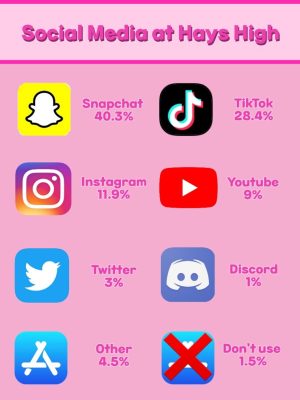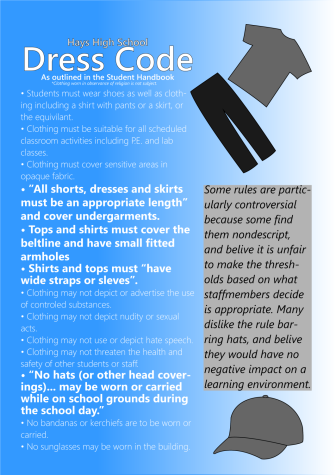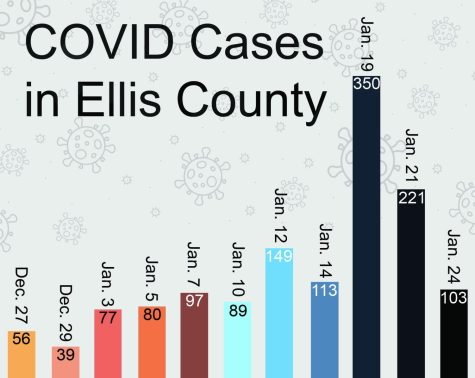Social media effects: Students discuss their social media usage, its impacts
During their Guided Personal Study class, students are allowed to use their free time to on go their phone if done with all their work. Juniors Grecia Enriquez and Katie Gutierrez talk about a picture on Enriquez’s feed.
We sent out a survey with fourteen questions asking students about their social media usage and experience. It was sent to sixty-seven Hays High School students: six freshmen, thirty sophomores, twenty-two juniors, and nine seniors. The survey asked the students what their most-used social media platform was, which ended up being Snapchat, with twenty-seven students selecting it. Facebook was the least used social media app, with no students choosing it. The students were then asked about their weekly screen time on said social media app. The average daily hourly rate per week from all the replies was nine hours and twenty-seven minutes.
“It has affected our generation negatively in much the same way it affected the generation before us – by taking away our free time. It used to be you could escape your social life when you came home, but not anymore.” Said senior Devlyn Jochum, “Furthermore, the widespread access to social media has made in-person conversations less common, resulting in our generation lacking basic communication skills.” The highest weekly number of hours spent on social media was forty-four, which would be around six hours a day. The app the student spent those hours on was Snapchat.
As the highest student screen time was forty-four hours, it is expected that students would be affected by social media. This was proven true in our survey, where 75% of students said they had been affected either mentally or physically. In these statistics, forty-five percent said their body image was affected, thirty-three percent feel the need to fit standards, forty-two percent are insecure, thirty percent are depressed, fifteen percent have lost friends, and seven percent have had thoughts of self-harm or suicide.
“There are several disclaimers about social media that affect health both mentally and physically, and other factors such as anxiety and perhaps depression.” said senior Kiki Gonzales. Social media can have the biggest impact on a teenager’s life and how they view themselves or others. Whether it be seeing more attractive people on their feed and becoming upset that you don’t look like them or seeing others on expensive, fancy trips with all their friends and being jealous because you don’t have that luxury. The littlest things can still make a huge difference in someone’s life, and they may not even realize it until it is too late.
In the past years, there has been a spike in the number of kids using social media, and the age of kids using it is starting to decrease. This is caused by a variety of reasons, but the main ones would be peer pressure, stress, depression, and the recent pandemic. Children are now starting to download social media apps around the age of 8–12, even though most platforms require the user to be 13 or older. It is now normal to lie about your age online, even on school websites when teachers tell you to make yourself a couple years older.
The most common apps being downloaded are Snapchat, TikTok, and Instagram. This increase in younger kids is also causing them to mature quicker and start behaving in ways that are not appropriate for their age. This includes showing off their body or sending nudes, cussing, smoking, drinking, talking to people much older than them, how they dress, etc. Now, maturing quicker is not always a bad thing; it can help them understand topics like mental health or social injustice. However, it is best to enjoy your innocence and let things run their course rather than following the crowd and rushing your childhood.
“I think social media has affected us both negatively and positively. Negatively because younger kids are exposed to a wide variety of things that can be unsafe.” said junior Grecia Enriquez, “Positively because people are able to spread information from around the world. For example, the protests in France are all over social media (Tik Tok), however, it is not talked about on the news.”
This year, 467 people have committed suicide in the United States, making our current suicide rate 14.0%. Overall, the total number of documented suicide deaths in Kansas is 531. The rate of suicide has increased as social media has become more popular over the years. In 2015, social media started to expand more and start to affect people’s daily lives. Also in 2015, the suicide rate started to increase. In 2015, 14.40% of people attempted suicide, and 16.10% attempted suicide in 2019. In approximately 4 years, the rate has jumped a whole 2%. With more social media trends being created and more people getting onto them, the rate will continue to grow and expand.
In our survey, one of the questions asked was if social media caused them to develop a self-harm addiction or suicidal thoughts. Five out of the sixty-seven respondents said they had suicidal thoughts or self-harmed. Suicide is the 12th leading cause of death for children in the US with firearms at 1st. Both causes can be tied back to social media and how it affects a child’s mind.
“It provides an easier way for bullies to target people and can affect people’s mental health by seeing unrealistic lifestyles, but it also allows us to connect with other people we wouldn’t meet otherwise.” said junior Sam Albin.


✧⋄⋆ Hi!!! I am senior Maddie Meis. I am the Copy Editor and News Editor in newspaper this year. I am also in yearbook, Environmental Club, play,...

I'm Katelyn Willemsen, and I'm a Senior at Hays High! I'm on the News Staff this year! I'm involved in Band, Yearbook, Quill & Scroll, Play, Musical, and...







